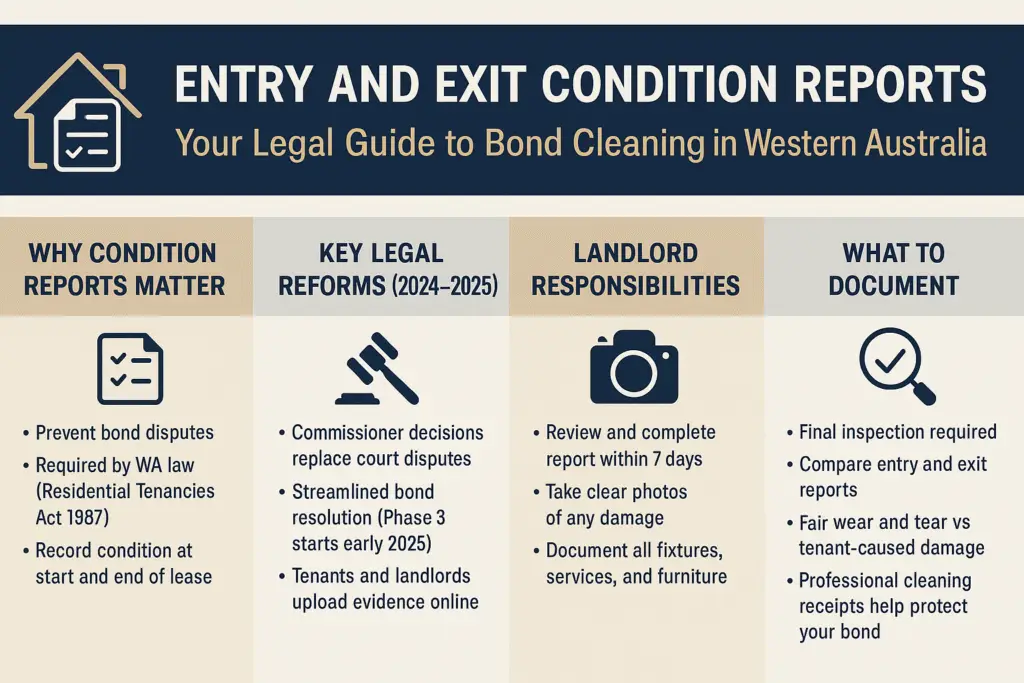Entry & Exit Condition Reports: Your Legal Guide to Bond Cleaning in Western Australia
Learn how Property Condition Reports safeguard your bond and help you stay in step with Western Australia’s changing tenancy laws.
Moving out of a rental property in Perth is stressful enough without the cloud of bond deductions hanging over your head. Recent amendments to Western Australia’s tenancy laws—alongside ongoing reforms to bond dispute resolution—mean that properly recording property condition has become a must for tenants and landlords alike.
Statistics show that cleaning disagreements are still the biggest reason for bond deductions nationwide. That’s why Property Condition Reports are your strongest safeguard. This guide explains how these vital documents affect bond cleaning responsibilities and why Perth tenants and landlords must use them. For comprehensive information on your obligations, see our guide to legal requirements of vacate cleaning in Perth.
What Are Property Condition Reports Under WA Law?
Property condition reports are needed when you rent a home in WA. They show how the place looks at both the start and the end of your tenancy. They help you tell what is fair wear and tear and what is damage, as well as who is in charge of maintenance or fixes. If you ever disagree about getting your bond back, these reports are important evidence, according to Consumer Protection Western Australia.
Under the Residential Tenancies Act 1987, Property Condition Reports (PCRs) are legal documents that keep an official record of the rental property’s state. Consumer Protection WA says you must fill in Property Condition Report (Form 1). It goes through the property’s parts and notes their condition, making clear if anything inside, outside, or nearby is broken or worn.
These reports are what you rely on to sort out what is regular wear and tear and what is damage you caused when you leave. That decision will determine whether you get back the full bond or if the landlord deducts cleaning or repair costs.
Recent Reforms Affecting Bond Disputes in WA
Western Australia’s residential tenancy laws are changing speedily, and these shifts will reshape how condition reports and bond disputes are managed. The Real Estate Institute of Western Australia (REIWA) explains that “Phase 1, which banned rent bidding and retaliatory conduct, began on 16 May 2024. Phase 2, which limits rent increases, regulates pets, allows modifications, and introduces a new Commissioner determination pathway, took effect on 29 July 2024. Phase 3, which will amend how bonds are released, should be in place by early 2025.”
Among the coming reforms, the move to a more straightforward dispute resolution pathway stands out. Consumer Protection WA has stated that “A simpler way is coming in 2025: Commissioner decisions. Either a landlord or tenant will be able to petition for a Commissioner determination. The bond claim will be examined, and a decision handed down on the payout, all without recourse to the court system.”
Once the Commissioner’s pathway is in place in 2025, bond disagreements—typically revolving around condition reports and cleaning expectations—will be adjudicated by the Commissioner for Consumer Protection, sparing parties the expense and formality of court disputes.
The Legal Requirements: Entry Reports
Landlord Responsibilities
Under the rules laid out by Consumer Protection WA, landlords are required to organise an inspection and fill in the prescribed condition report prior to a tenant’s arrival, and then hand out two copies of this report to the tenant within seven days of them moving in. It is also recommended that both the landlord and the tenant take dated photos to support the report.
These requirements are designed to establish an agreed and recorded picture of the property’s state before the lease starts. For landlords, not delivering the report within the timeframe can seriously undermine their argument in any subsequent bond claims.
Tenant Responsibilities
As a tenant, you have clear legal duties regarding the Entry Condition Report that can significantly affect the protection of your bond money. Consumer Protection WA advises that you should read the Property Condition Report (PCR) carefully, complete your section, photograph the property, and attach those photos to the report, ensuring each photo is date-stamped. Examine every fixture and fitting, confirming that items such as the TV aerial, air conditioners, the dishwasher, the oven, and the hot water system are present and functional. Verify that all agreed services—cable TV, internet, NBN, and phone—are installed and operational. If any furniture was supplied, check for rips or stains on couches, scratches on the shelves, and any other damage. Document any issues or items that require repair on both copies of the report, return one complete copy to the landlord within seven days of receiving the PCR, and attach the photos of any problems to that copy so the landlord can carry out required repairs. Retain the other copy for your personal files.
That seven-day period is critical—if you let it pass, you could be held responsible for damage that existed before you moved in.
What to Document
Clear and comprehensive documentation shields landlords and tenants alike, significantly lowering the chance of future bond disagreements. As Consumer Protection WA suggests, the report should pinpoint issues like: “torn flyscreen in bedroom one, crack along left side of northern wall in kitchen, circular brown stain on lounge room carpet, broken bathroom door handle.”
Specificity is the guiding principle. General phrases such as “some wear” or “minor damage” carry little weight in a dispute. Instead, ensure the report covers:
- Exact locations of all damage or wear
- Measurements of stains, scratches, or breaks
- Issues affecting functionality of appliances, fixtures, or systems
- Photographs with visible timestamps
- Items needing immediate repair or attention
Focus on Common Cleaning Areas
While preparing entry condition records, place extra emphasis on spots that typically prompt scrutiny during final-clean inspections. Consider using a comprehensive end-of-lease cleaning checklist to ensure nothing is missed:
- Kitchen appliances (ovens, rangehoods, dishwashers)
- Bathroom fixtures (shower screens, tiles, grout)
- Carpet and flooring condition
- Window tracks and coverings
- Walls and scuff marks
- Light fixtures and ceiling fans
Understanding what constitutes professional bond cleaning can help you better assess property condition during both entry and exit inspections.
At Majestic Vacate Cleaning Perth, we’ve repeatedly noted that properties backed by thorough, well-structured entry reports experience far fewer bond disputes, since both landlords and tenants start with a mutual understanding of the required cleaning standard.
Exit Condition Reports: Your Final Protection
The Legal Framework
Under Consumer Protection WA, when a tenant vacates a rental property, the landlord is responsible for conducting a final inspection and completing a Property Condition Report (PCR). The landlord must then provide the tenant with a copy of the PCR within 14 days of the tenant’s move-out date.
Meeting this 14-day deadline is critical for tenants: if a landlord fails to issue the report on time, it jeopardises their ability to lodge a valid claim against the tenant’s bond for any disputed damage.
The Inspection Process
Consumer Protection WA advises that landlords and tenants should, wherever possible, conduct the final inspection together to resolve any matters on the spot. However, the report can still go ahead without the tenant if the landlord can demonstrate that the tenant was given a fair and reasonable chance to attend. “Reasonable” reflects a general community standard, so property managers should take into account the work patterns of both tenants and landlords. In Perth, this often means considering FIFO rosters, rotating shifts, or other unusual work hours, and it may require property managers to offer multiple inspection windows or to reschedule when work commitments can be verified.
How Condition Reports Determine Bond Outcomes
The Comparison Process
Your bond’s fate hinges on the side-by-side look at the entry and exit condition reports. Consumer Protection WA notes, “Looking at the condition reports at the beginning and end of the tenancy shows what’s just normal use and what’s actually damage.”
The rules are straightforward. Consumer Protection WA clarifies, “The bond must be returned to tenants unless the landlord shows there’s damage to the premises caused by the tenant or their pet. Fair wear and tear can’t be charged to the bond.”
What Constitutes Fair Wear and Tear vs. Damage
Knowing what falls into each box is key for keeping your bond. For a detailed breakdown, see our comprehensive guide to fair wear and tear vs. damage:
Fair Wear and Tear (Cannot be claimed from bond):
- Light scuff marks on walls from everyday living
- Thin areas of carpet wear in well-used spots
- Faded curtains from sunlight over time
- Tiny holes from hanging pictures on the wall
- A normal buildup of dust or dirt
Tenant Damage (Can be claimed from bond):
- Large fist-sized holes in the drywall
- Deep stains in the carpet that won’t come out
- Broken fixtures or appliances from rough use
- Excessive dirt needing a professional clean beyond what’s expected
- Pet damage beyond normal wear
Bond Cleaning: Complying with the Law
Condition reports set the yardstick for what you need to tackle when the lease is up. In WA, you must return the place as you got it, minus fair wear and tear. In practice, though, many property managers expect cleaning that goes beyond the bare legal minimum.
Proof of Professional Cleaning
More property managers are asking for a receipt from a professional cleaner to prove you’ve done the end-of-lease tidy-up properly. There are clear reasons for this demand: the receipt gives both landlords and tenants a record that the job was done to a recognised standard. Professional bond cleaning services such as Majestic Vacate Cleaning Perth know exactly what local property managers want. We tailor our cleaning to those guidelines, which helps you avoid any unnecessary bond deductions.
Common Condition Report Disputes
Cleaning-Related Issues
Most bond disputes come down to differing opinions on what “clean” really means. If the initial condition report isn’t thorough, tenants can be hit with claims like:
- Charges for a professional oven clean when the unit was already soiled at the start
- Carpet-cleaning fees for marks that were visible before the lease
- Window-cleaning fees for panes that were never done during the tenancy
- Requests for a deep clean in the bathroom for build-up that predates the current tenancy
Resolution Through New Commissioner Process
As the Network Exchange Real Estate team explains in the run-up to the 2024 reforms, “Complaints about pets, small changes, and bond returns will go directly to the Commissioner for Consumer Protection, cutting out the court queue. Both sides upload their evidence online.”
This faster system, kicking off in 2025, will depend on clear, detailed condition reports to deliver fair outcomes in bond disputes.
Best Practices for Tenants
At Move-In
- Conduct a thorough inspection during the first week
- Capture clear photos with date stamps
- Write down everything, even tiny details
- Send your report within the seven-day window
- Save copies of all your documents
During Tenancy
- Take ongoing photos of the property’s condition
- Report maintenance problems immediately to stop further damage
- Keep receipts for repairs or upgrades you pay for
- Log any shifts in how the property looks over time
At Move-Out
- Do a thorough vacate clean
- Photograph everything after the clean’s done
- Join the final inspection if you can
- Save all cleaning invoices and related documents
- Look over the exit condition report before you sign
Professional Cleaning and Condition Reports
In Perth’s competitive rental market, condition reports and professional cleaning are closely linked. At Majestic Vacate Cleaning Perth we’ve found that homes with clear, precise reports usually breeze through the bond return process.
Why Trusted Cleaning Services Matter
- Alignment with documented standards: Trained cleaners know exactly what level of cleanliness meets the benchmarks listed in condition reports
- Proof of diligence: Receipts from licensed cleaning firms serve as hard evidence that the mandatory cleaning was performed
- Sector insight: Experienced teams are aware of the precise spots property managers tend to examine most closely
- Mitigating financial risk: Many professional cleaning companies offer guarantees to offset the risk of unexpected bond deductions
Understanding the key differences between DIY and professional cleaning can help you make an informed decision about your bond cleaning approach.
How Weak Documentation Costs You Money
When condition reports are incomplete, the financial fallout can escalate quickly:
- Bond deductions assessed for wear already present, misattributed to incoming tenants
- Legal fees incurred should disagreement escalate to court
- Lost time and peace of mind tied to lengthy dispute resolution procedures
- Extra cleaning charges that proactive documentation could have prevented
Picture this: A tenant moves in to find the entry condition report skimping on details, missing the fact that the carpet already had stains. At move-out, the landlord invoices $400 for professional carpet cleaning. Without an entry report showing those stains were there from day one, the tenant lacks any defense and forfeits the entire amount from the bond.
To avoid such situations, consider our guide to maximizing your deposit return through proper documentation and cleaning practices.
Technology and Modern Condition Reports
Although Western Australian legislation still mandates submission of the Form 1 Property Condition Report, technological advancements are refining the methods by which these reports are compiled and archived:
- Timestamp-verified digital photography captures current property condition with audit trail integrity
- Cloud-based storage solutions offer encrypted space for long-term, tamper-evident retention of signed reports
- Mobile applications guide inspectors through templated questionnaires, auto-generating compliant documents while offline
- Video walkthroughs provide a dynamic, supplementary record that can clarify points not easily represented in still images
It remains critical, however, that these digital enhancements act only as adjuncts; the Form 1 Report itself must still be the document of record as stipulated by WA legislation.
Legal Rights and Support Services
Legal Aid WA highlights tenants’ essential entitlements under the law: “The Residential Tenancies Act 1987 (WA) (the Act) clarifies the rights and duties of both tenants and landlords (sometimes called lessors) and provides a framework for resolving conflicts. The Act governs your situation regardless of whether a formal lease or written agreement exists.”
If conflict arises, Legal Aid WA advises that “Certain disagreements between landlords and tenants may now be addressed by the Commissioner for Consumer Protection. Matters involving a tenant’s right to keep a pet, to make minor alterations, or to obtain a security bond refund can be lodged with the Commissioner.”

Conclusion: Protecting Your Bond Investment
In Western Australia, Property Condition Reports remain your principal safeguard against bond disputes. As forthcoming reforms simplify the resolution of bond matters through Commissioner rulings, the value of complete and precise records will only increase.
Perth tenants and landlords should note these essential points:
- Fill out condition reports carefully and without delay
- Document everything with clear, detailed photos
- Know the difference between normal wear and actual damage
- If necessary, hire professional cleaners to meet required benchmarks
- Save every piece of paperwork for the duration of the lease
For additional guidance, explore our comprehensive bond cleaning guide to understand every aspect of the process.
Whether you are a tenant wanting to ensure your bond is safe or a landlord wishing to protect your property, thorough reports create a necessary layer of legal security for everyone involved.
Looking for professional bond cleaning in Perth? Majestic Vacate Cleaning Perth delivers the high standards you’ll see in condition reports, backed by a 14-day bond back guarantee. Our cleaners know precisely what property managers check for at the last inspection. Reach out at (08) 6185 0866 or grab an instant quote on our website to make sure your bond refund is a done deal.

